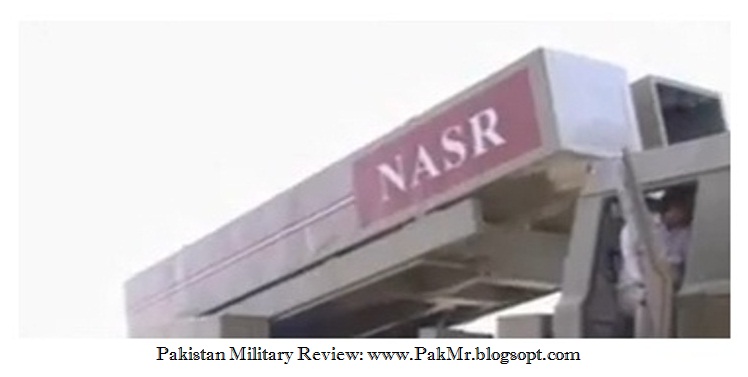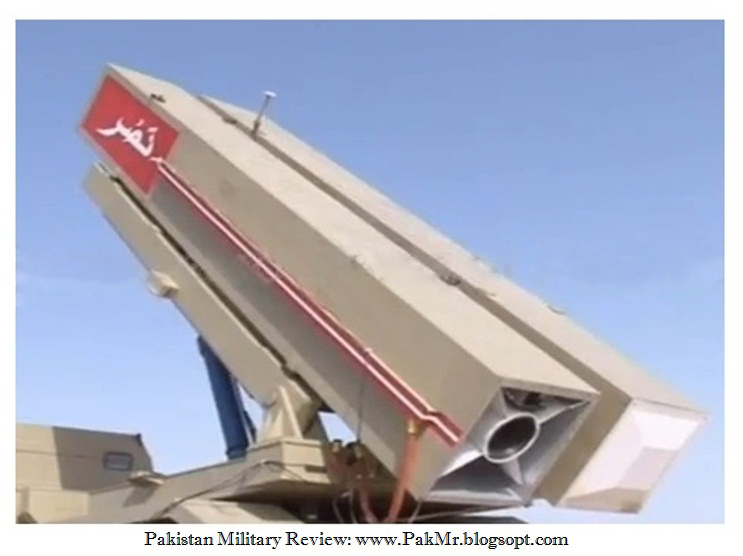
هذه الصورة لا تزال من صدقة باكستان فيديو يظهر العسكرية التي اطلقت التاسع حتف (نصر) خلال اختبار صاروخ في مكان لم يكشف عنه في باكستان 19 أبريل ، 2011. -- صورة من رويترز
سنغافورة : اختبار باكستان بنجاح صاروخا قادرا على حمل أسلحة نووية قصيرة المدى يهدد بزيادة حدة التوتر في منطقة متوترة بالفعل أن وفاة اسامة بن لادن سوف يخلق المزيد من عدم الاستقرار.
الأسلحة التكتيكية النووية ، وتسمى هذه ، غالبا ما ينظر بأنها أكثر خطورة من الأسلحة الاستراتيجية التقليدية بسبب صغر حجمها ، والتعرض للإساءة. سرقة يجعلها خطرا على الأمن العالمي.
وأكثر ما يثير القلق هو أن ينظر إلى هذه الأسلحة منخفضة الغلة إلى أن تستخدم أقل تدميرا ، وبالتالي أكثر عرضة من فئات أخرى من الأسلحة ، مما اضطر معظم الدول النووية لتقليل المخاطر عن طريق خفض المخزونات.
خبراء باكستانيون واضطرت البلاد إلى تطوير أسلحة نووية تكتيكية بسبب خطة الهند "الباردة ابدأ" التي يتم بموجبها تستعد القوات الهندية لتنفيذ ضربة خاطفة داخل باكستان إذا تتبعت هجوم آخر على غرار هجمات مومباي العودة إلى جماعات متشددة مقرها باكستان .
وقال الجيش انها اختبرت الشهر الماضي ان 60 كيلومترا (36 ميلا) مجموعة النصر للسطح إلى سطح الصاروخ الذي يحمل الرؤوس النووية الى تعزيز "الردع في المديين القصير".
خبراء الأمن في الولايات المتحدة ، وقالت الهند وباكستان كان ذلك يعني ان الجيش يخطط لنشر هذه الأسلحة في ساحة المعركة ، وتصاعد المنافسة الإقليمية النووي الذي بدا في كثير من الأحيان تكرار التنافس بين الولايات المتحدة والاتحاد السوفيتي خلال الحرب الباردة.
"التنمية في باكستان واختبار صواريخ قصيرة المدى ذات قدرات نووية يشكل تطورا مزعزعا للاستقرار ويحتمل أن تكون خطرة" ، وقال داريل كيمبال زاي ، المدير التنفيذي للأسلحة ومقرها واشنطن جمعية مراقبة.
"ويشير إلى أن باكستان سوف تفكر بجدية استخدام في ميدان المعركة في حال شن هجوم من قبل القوات الهندية."
قد تستجيب الهند حتى الآن من تصاعد الرؤوس النووية على صواريخها ذات المدى الأقصر لمواجهة التهديد الباكستاني. اختباره منخفضة الغلة الأجهزة النووية في عام 1998 ولكن لم تكن هناك كلمة ومنذ ذلك الحين على ما إذا كان قد أضاف لهم ترسانتها.
"من المعروف لدينا القدرة في مجال الأجهزة منخفضة الغلة الانشطار" ، وقال العلماء السابقين وزارة الدفاع الهندية المشاركة في الاختبارات 1998 ، الخوض في تفاصيل.
وردت باكستان على تجارب الهند مع انفجارات من تلقاء نفسها. كل الأمم ومنذ ذلك الحين تم توسيع ترسانتهم ، باكستان أكثر وبوتيرة التي يقول خبراء غربيون ، قد غضون عقد من الزمن ، وجعله رابع أكبر قوة الأسلحة ، وراء الولايات المتحدة وروسيا والصين.
وتقول باكستان انها استثمرت الكثير من الموارد لضمان أن المرافق النووية والمواد والأسلحة آمنة.
ولكن زاد من دعم باكستان للجماعات متشددة من بينها تنظيم القاعدة وحركة طالبان ، الذين وجدوا ملاذا على طول الحدود الأفغانية ، ودائما مخاوف بشأن ترسانة الآخذة في الاتساع من أي وقت مضى. هذه المخاوف تعمقت بعد العثور على بن لادن زعيم تنظيم القاعدة وقتل في بلدة حامية.
وقال غاري سامور وإذا كان هناك بلد واحد المسلحة نوويا التي أبقته مستيقظا في الليل ، وكانت باكستان ، كبير منسقي البيت الابيض بشأن أسلحة الدمار الشامل والإرهاب.
وقال "ما يدعو للقلق هو أنه ، في إطار أوسع من التوترات والمشاكل داخل المجتمع الباكستاني ونظام الحكم... حتى تدابير أمنية أفضل النووية قد تنهار" ، وقال سامور في مقابلة نشرت في عدد أيار / مايو 2011 لمراقبة التسلح اليوم.
"أنت التعامل مع هذا البلد الذي يتعرض لضغوط هائلة داخليا وخارجيا ، وهذا ما يجعلني قلق".
فرقت الأسلحة
المشكلة مع نشر أسلحة تكتيكية للوصول إلى ساحة المعركة هو أن القيادة والسيطرة يجب أن تكون مشتتة وصولا الى وحدات عسكرية على أرض الواقع.
وهذا يزيد من خطر الأمور تسير بشكل خاطئ ، إما عن طريق الخطأ في التقدير ، وقوع حادث أو سيناريو كابوس تسلل الجماعات المسلحة ، ويقول الخبراء النوويين.
وفي كلتا الحالتين ، مرة واحدة باكستان أطلقت صاروخا قبالة ، انها ستدعو الانتقام ، ومدى الذي هو غير معروف.
داخل باكستان نفسها ، وشكك خبراء أمنيون ان منطق نشر الأسلحة التكتيكية ، بحجة أنه تعرض البلاد لمخاطر أكبر بدلا من تحسين الأمن.
وقال اعجاز حيدر ، وهو خبير امني باكستاني وكاتب عمود ، اذا كانت باكستان ستطلق هذه الأسلحة والجيش الهندي يعبر الحدود ، فإنها تكون فعالة إفلاتها على اراضيها.
"نحن ، بالطبع ، لا تفكر حتى كيف يمكن أن يتعرض قواتنا والسكان لتداعيات من TNW (الأسلحة النووية التكتيكية) ،" وقال حيدر.
لكن العديد من الخبراء يقولون أيضا أن ينظر مذهب الهند ابدأ الباردة ، حتى لو كانت لا تعمل بكامل طاقتها ، كما يشكل تهديدا حقيقيا في باكستان.
ويهدف الباردة البدء في تصاعد عمليات التوغل العسكري السريع في باكستان لمعاقبتها ، واتخاذ كميات محدودة من الأرض ، ومن ثم تفاوض لاجبار اسلام اباد لكبح جماح الجماعات المسلحة التي تعمل ضد الهند.
لا يهدف الى تهديد للدولة الباكستانية إلى اللجوء إلى خيارها النهائي ، النووي ، لكنها مغامرة محفوفة بالمخاطر.
Pakistan builds low yield nuclear capability amid concerns

This still image from a Pakistan military handout video shows a Hatf IX (NASR) missile being fired during a test at an undisclosed location in Pakistan April 19, 2011. - Photo by Reuters
SINGAPORE: Pakistan’s successful test of a missile able to carry short range nuclear weapons threatens to raise tensions in a region already nervous that the death of Osama bin Laden will create more instability.
Tactical nuclear weapons, as these are called, are often seen as more dangerous than the traditional strategic weapons because their small size and vulnerability to misuse. Theft makes them a risk to global security.
The biggest concern is that these low yield weapons are seen as less destructive and therefore more likely to be used than other classes of weapons, forcing most nuclear states to minimise the risk by cutting back stockpiles.
Pakistani experts say the country has been forced to develop tactical nuclear weapons because of India’s “Cold Start” plan under which Indian troops are primed to carry out a lightning strike inside Pakistan if another Mumbai-style attack is traced back to Pakistan-based militant groups.
The military said it had tested last month the 60-km (36-mile) range NASR surface-to-surface missile which carries nuclear warheads to boost “deterrence at short ranges”.
Security experts in the United States, India and Pakistan said it meant the military planned to deploy these weapons in the battlefield, escalating the regional nuclear competition that has often seemed a replay of the US-Soviet rivalry during the Cold War.
“Pakistan’s development and testing of nuclear-capable short-range missiles is a destabilizing and potentially dangerous development,” Daryl G. Kimball, the executive director of the Washington-based Arms Control Association, said.
“It suggests that Pakistan would seriously contemplate use on the battlefield in the event of an incursion by Indian forces.”
India may yet respond by mounting nuclear warheads on its shorter range missiles to meet the Pakistani threat. It tested low yield nuclear devices in 1998 but there has been no word since then on whether it has added them to its arsenal.
“Our capability in the area of low yield fission devices is well known,” a former Indian defence scientist involved in the 1998 tests said, declining further comment.
Pakistan responded to India’s tests with explosions of its own. Both nations have since been expanding their arsenal, Pakistan even more and at a pace that Western experts say may, within a decade, make it the fourth largest weapons power, behind the United States, Russia and China.
Pakistan says it has invested a lot of resources to ensure that its nuclear facilities, materials and weapons are secure.
But Pakistan’s support for militant groups including al Qaeda and the Taliban, who have found sanctuary along the Afghan border, has always heightened concerns about its ever expanding armoury. These worries have deepened after al Qaeda leader bin Laden was found and killed in a garrison town.
If there was one nuclear-armed country that kept him awake at night, it was Pakistan, senior White House coordinator on weapons of mass destruction and terrorism, Gary Samore said.
“What I worry about is that, in the broader tensions and problems within Pakistani society and polity…even the best nuclear security measures might break down,” Samore said in an interview published in the May 2011 issue of Arms Control Today.
“You’re dealing with a country that is under tremendous stress internally and externally, and that’s what makes me worry.”
DISPERSED WEAPONS
The problem with deploying tactical weapons to the battlefield is that command and control has to be dispersed down to military units on the ground.
This increases the risk of things going wrong, either through miscalculation, an accident or the nightmare scenario of infiltration by militant groups, nuclear experts say.
In either case, once Pakistan had fired off the missile, it would invite retaliation, the extent of which is unknown.
Within Pakistan itself, security experts have questioned the logic of deploying tactical weapons, arguing that it exposed the country to bigger risks rather than improving security.
Ejaz Haider, a Pakistani security expert and columnist, said if Pakistan is going to unleash these weapons as the Indian military crosses the border, it would effectively be dropping them on its own soil.
“We are, of course, not even considering how our own troops and population would be exposed to the fallout from a TNW (tactical nuclear weapon),” Haider said.
But several experts also say that India’s Cold Start doctrine, even if it is not fully operational, is seen as a real threat in Pakistan.
Cold Start is aimed at mounting rapid military incursions into Pakistan to punish it, take limited amounts of territory, and then negotiate to compel Islamabad to rein in militant groups that act against India.
It is not aimed at threatening the Pakistani state into resorting to its final, nuclear option, but it’s a risky gamble.

مصادر


مصادر
ليس لديك تصريح لمشاهدة الرابط، فضلا قم ب تسجيل الدخول او تسجيل
ليس لديك تصريح لمشاهدة الرابط، فضلا قم ب تسجيل الدخول او تسجيل
ليس لديك تصريح لمشاهدة الرابط، فضلا قم ب تسجيل الدخول او تسجيل
ليس لديك تصريح لمشاهدة الرابط، فضلا قم ب تسجيل الدخول او تسجيل
.”
